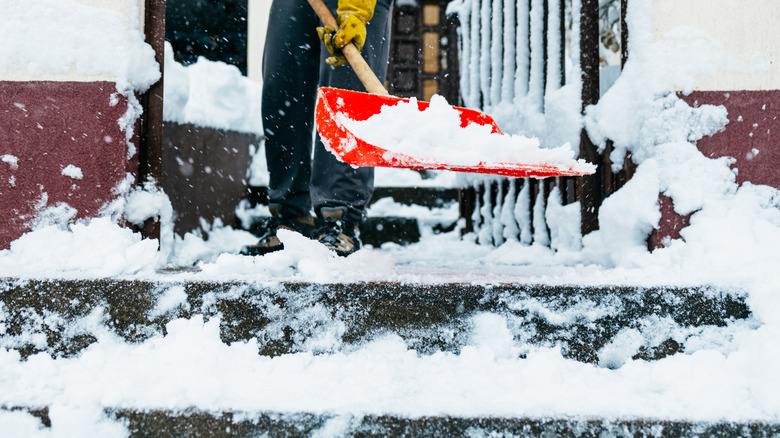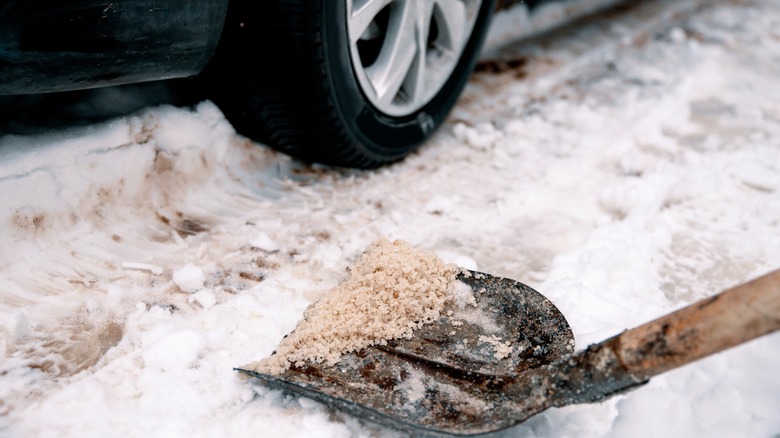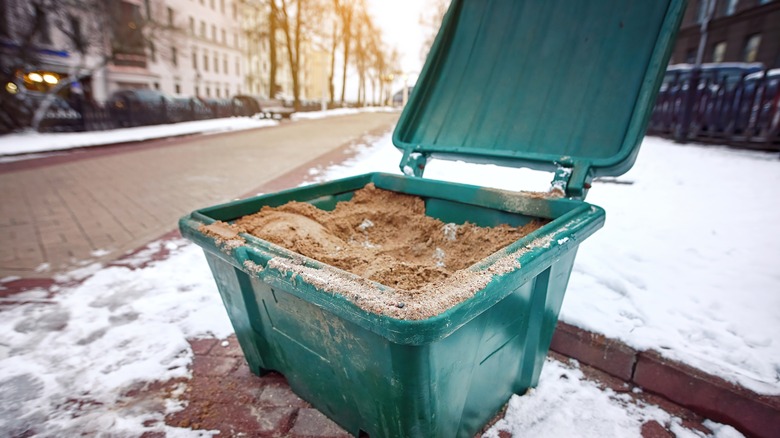Salt Or Sand: Which Is The Best To Melt Ice For Winter Driveway Safety
The beach is probably the last thing on your mind while shoveling snow from your driveway. And while thoughts of warmer, sunnier days may seem pointless–you've already prepped your home for cold weather–perhaps it's worth asking why snow doesn't last very long on those balmy strips of heaven. Just as salt and sand work together to keep a beach safe and clear, they're also two of winter's most dependable tools for tackling icy driveways and walkways. When applied correctly, each can make winter conditions safer—one by liquefying ice, the other by improving traction. Because if you can't melt the snow, you better hope that you can walk on it. So, homeowners across cold climates stock up on salt and sand every year, but few pause to consider which is best for their driveway or whether a combination might yield better results.
Municipalities often mix salt and sand for maximum efficiency, balancing grip and thawing power for roads and high-traffic areas. For your driveway, a similar approach may be ideal, but choosing the right balance depends on your specific needs and local conditions. Here's a deeper look into how salt and sand each work to make driveways safer and how they can complement one another to help you stay on your feet this winter.
A little bit of salt goes a long way
There are simple ways to make driveway snow removal easier. And salt remains a popular choice for de-icing your driveway due to its ease of use and how quickly it can dissolve snow. Salt (sodium chloride) melts ice by lowering the freezing point of water through a process called freezing point depression, allowing water to remain in liquid form at temperatures below the standard freezing mark of 32 degrees Fahrenheit. When you throw salt on ice, it starts thawing, creating a brine solution that spreads and prevents more ice from forming. Salt can work effectively in moderate winter temperatures above 15 degrees Fahrenheit, which is perfect for most winter weather scenarios. It is also often the quickest, most straightforward de-icing option for light snowfall or minor ice buildup.
However, salt has its drawbacks. Sodium chloride can seep into surrounding plants, soil, and groundwater, potentially harming plant roots and altering soil composition. Salt can also damage concrete, metals, and asphalt surfaces, increasing the chances of corrosion and wear. Therefore, it's best to use salt sparingly, applying it only when temperatures are optimal and ice buildup is likely. Experts recommend using about one handful of salt per square yard, just enough to create an even layer without excess runoff. You also have to consider the timing of applying your salty layer outside. Salt works best before heavy snowfall, as applying it in advance can prevent ice from bonding to surfaces.
Get a grip with sand
Sand improves traction on icy surfaces without melting the ice itself. One of the handiest hacks to take care of snow and ice is to place a layer of dirt outside. It adds friction, making it particularly valuable on steep driveways or high-traffic areas for added grip. As a bonus, temperature doesn't change sand's efficacy, so it works well in extremely cold conditions–where salt may not. This makes it a no-brainer in areas with severe winters and temperatures consistently below sodium chloride's melting range of 15 degrees Fahrenheit. Sand won't harm plants or local wildlife, making it one of the more environmentally friendly winter safety options. For best results, apply it damp so it doesn't blow away.
However, sand still has some limitations. Unlike salt, it won't actively melt ice, so it requires frequent reapplication, especially after fresh snowfall. There's also the danger of sand clogging storm drains and runoff areas. Another factor to consider is that while sand is generally safe for concrete and metal, the abrasive nature of sand particles can gradually wear down surfaces over time. For those who prefer both traction and some de-icing, combining sand and salt can create a practical balance that reduces the need for frequent applications. It's also wise to apply sand over existing ice patches and along high-traffic paths.


